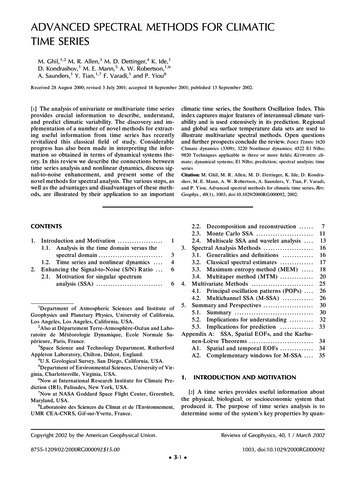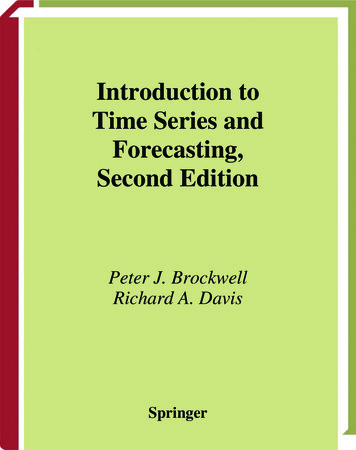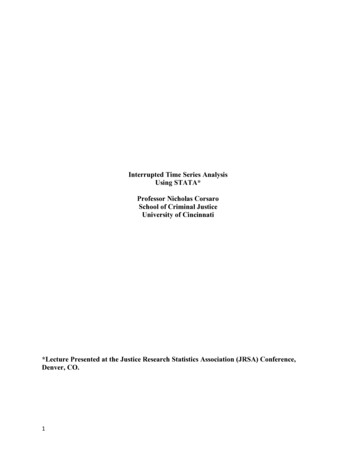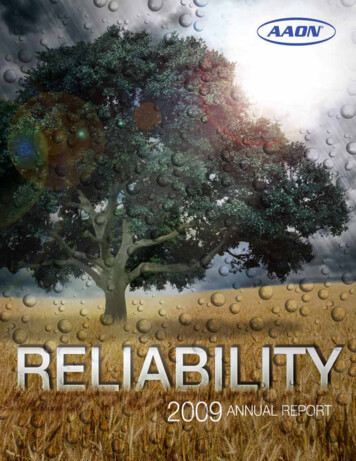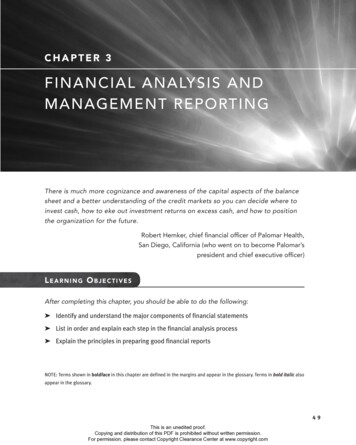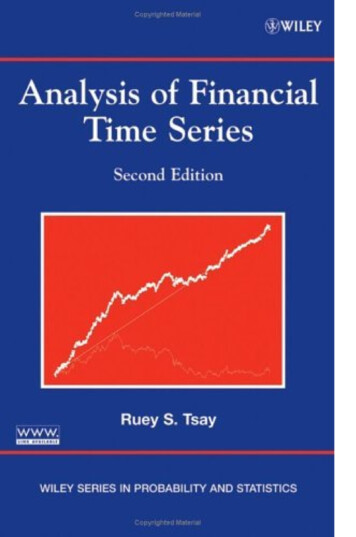
Transcription
Analysis of Financial Time SeriesSecond EditionRUEY S. TSAYUniversity of ChicagoGraduate School of BusinessA JOHN WILEY & SONS, INC., PUBLICATION
Analysis of Financial Time Series
WILEY SERIES IN PROBABILITY AND STATISTICSEstablished by WALTER A. SHEWHART and SAMUEL S. WILKSEditors: David J. Balding, Noel A. C. Cressie, Nicholas I. Fisher,Iain M. Johnstone, J. B. Kadane, Geert Molenberghs, Louise M. Ryan,David W. Scott, Adrian F. M. Smith, Jozef L. TeugelsEditors Emeriti: Vic Barnett, J. Stuart Hunter, David G. KendallA complete list of the titles in this series appears at the end of this volume.
Analysis of Financial Time SeriesSecond EditionRUEY S. TSAYUniversity of ChicagoGraduate School of BusinessA JOHN WILEY & SONS, INC., PUBLICATION
Copyright 2005 by John Wiley & Sons, Inc. All rights reserved.Published by John Wiley & Sons, Inc., Hoboken, New Jersey.Published simultaneously in Canada.No part of this publication may be reproduced, stored in a retrieval system, or transmitted in any formor by any means, electronic, mechanical, photocopying, recording, scanning, or otherwise, except aspermitted under Section 107 or 108 of the 1976 United States Copyright Act, without either the priorwritten permission of the Publisher, or authorization through payment of the appropriate per-copy feeto the Copyright Clearance Center, Inc., 222 Rosewood Drive, Danvers, MA 01923, (978) 750-8400,fax (978) 750-4470, or on the web at www.copyright.com. Requests to the Publisher for permissionshould be addressed to the Permissions Department, John Wiley & Sons, Inc., 111 River Street,Hoboken, NJ 07030, (201) 748-6011, fax (201) 748-6008, or online athttp://www.wiley.com/go/permission.Limit of Liability/Disclaimer of Warranty: While the publisher and author have used their best effortsin preparing this book, they make no representations or warranties with respect to the accuracy orcompleteness of the contents of this book and specifically disclaim any implied warranties ofmerchantability or fitness for a particular purpose. No warranty may be created or extended by salesrepresentatives or written sales materials. The advice and strategies contained herein may not besuitable for your situation. You should consult with a professional where appropriate. Neither thepublisher nor author shall be liable for any loss of profit or any other commercial damages, includingbut not limited to special, incidental, consequential, or other damages.For general information on our other products and services or for technical support, please contact ourCustomer Care Department within the United States at (800) 762-2974, outside the United States at(317) 572-3993 or fax (317) 572-4002.Wiley also publishes its books in a variety of electronic formats. Some content that appears in printmay not be available in electronic formats. For more information about Wiley products, visit our website at www.wiley.com.Library of Congress Cataloging-in-Publication Data:Tsay, Ruey S., 1951–Analysis of financial time series/Ruey S. Tsay.—2nd ed.p. cm.“Wiley-Interscience.”Includes bibliographical references and index.ISBN-13 978-0-471-69074-0ISBN-10 0-471-69074-0 (cloth)1. Time-series analysis. 2. Econometrics. 3. Risk management. I. Title.HA30.3T762005332 .01 51955—dc222005047030Printed in the United States of America.10 9 8 7 6 5 4 3 2 1
To my parents and Teresa
ContentsPrefacexviiPreface to First Editionxix1.Financial Time Series and Their Characteristics11.11.2Asset Returns, 2Distributional Properties of Returns, 71.2.1 Review of Statistical Distributions and Their Moments, 71.2.2 Distributions of Returns, 131.2.3 Multivariate Returns, 161.2.4 Likelihood Function of Returns, 171.2.5 Empirical Properties of Returns, 171.3Processes Considered, 20Exercises, 22References, 232.Linear Time Series Analysis and Its Applications2.12.22.32.424Stationarity, 25Correlation and Autocorrelation Function, 25White Noise and Linear Time Series, 31Simple Autoregressive Models, 322.4.1 Properties of AR Models, 332.4.2 Identifying AR Models in Practice, 402.4.3 Goodness of Fit, 462.4.4 Forecasting, 47vii
viiiCONTENTS2.5Simple Moving-Average Models, 502.5.1 Properties of MA Models, 512.5.2 Identifying MA Order, 522.5.3 Estimation, 532.5.4 Forecasting Using MA Models, 542.6Simple ARMA Models, 562.6.1 Properties of ARMA(1,1) Models, 572.6.2 General ARMA Models, 582.6.3 Identifying ARMA Models, 592.6.4 Forecasting Using an ARMA Model, 612.6.5 Three Model Representations for an ARMA Model, 622.7Unit-Root Nonstationarity, 642.7.1 Random Walk, 642.7.2 Random Walk with Drift, 652.7.3 Trend-Stationary Time Series, 672.7.4 General Unit-Root Nonstationary Models, 672.7.5 Unit-Root Test, 682.8Seasonal Models, 722.8.1 Seasonal Differencing, 732.8.2 Multiplicative Seasonal Models, 752.9Regression Models with Time Series Errors, 802.10 Consistent Covariance Matrix Estimation, 862.11 Long-Memory Models, 89Appendix: Some SCA Commands, 91Exercises, 93References, 963.Conditional Heteroscedastic Models3.13.23.33.43.5Characteristics of Volatility, 98Structure of a Model, 99Model Building, 1013.3.1 Testing for ARCH Effect, 101The ARCH Model, 1023.4.1 Properties of ARCH Models, 1043.4.2 Weaknesses of ARCH Models, 1063.4.3 Building an ARCH Model, 1063.4.4 Some Examples, 109The GARCH Model, 1133.5.1 An Illustrative Example, 11697
ixCONTENTS3.5.2 Forecasting Evaluation, 1213.5.3 A Two-Pass Estimation Method, 1213.6The Integrated GARCH Model, 1223.7The GARCH-M Model, 1233.8The Exponential GARCH Model, 1243.8.1 An Alternative Model Form, 1253.8.2 An Illustrative Example, 1263.8.3 Second Example, 1263.8.4 Forecasting Using an EGARCH Model, 1283.9The Threshold GARCH Model, 1303.10 The CHARMA Model, 1313.10.1 Effects of Explanatory Variables, 1333.11 Random Coefficient Autoregressive Models, 1333.12 The Stochastic Volatility Model, 1343.13 The Long-Memory Stochastic Volatility Model, 1343.14 Application, 1363.15 Alternative Approaches, 1403.15.1 Use of High-Frequency Data, 1403.15.2 Use of Daily Open, High, Low, and Close Prices, 1433.16 Kurtosis of GARCH Models, 145Appendix: Some RATS Programs for Estimating Volatility Models, 147Exercises, 148References, 1514.Nonlinear Models and Their Applications4.14.2Nonlinear Models, 1564.1.1 Bilinear Model, 1564.1.2 Threshold Autoregressive (TAR) Model, 1574.1.3 Smooth Transition AR (STAR) Model, 1634.1.4 Markov Switching Model, 1644.1.5 Nonparametric Methods, 1674.1.6 Functional Coefficient AR Model, 1754.1.7 Nonlinear Additive AR Model, 1764.1.8 Nonlinear State-Space Model, 1764.1.9 Neural Networks, 177Nonlinearity Tests, 1834.2.1 Nonparametric Tests, 1834.2.2 Parametric Tests, 1864.2.3 Applications, 190154
xCONTENTS4.34.4Modeling, 191Forecasting, 1924.4.1 Parametric Bootstrap, 1924.4.2 Forecasting Evaluation, 1924.5Application, 194Appendix A: Some RATS Programs for Nonlinear VolatilityModels, 199Appendix B: S-Plus Commands for Neural Network, 200Exercises, 200References, 2025.High-Frequency Data Analysis and Market Microstructure2065.15.25.35.4Nonsynchronous Trading, 207Bid–Ask Spread, 210Empirical Characteristics of Transactions Data, 212Models for Price Changes, 2185.4.1 Ordered Probit Model, 2185.4.2 A Decomposition Model, 2215.5Duration Models, 2255.5.1 The ACD Model, 2275.5.2 Simulation, 2295.5.3 Estimation, 2325.6Nonlinear Duration Models, 2365.7Bivariate Models for Price Change and Duration, 237Appendix A: Review of Some Probability Distributions, 242Appendix B: Hazard Function, 245Appendix C: Some RATS Programs for Duration Models, 246Exercises, 248References, 2506.Continuous-Time Models and Their Applications6.16.26.3Options, 252Some Continuous-Time Stochastic Processes, 2526.2.1 The Wiener Process, 2536.2.2 Generalized Wiener Processes, 2556.2.3 Ito Processes, 256Ito’s Lemma, 2566.3.1 Review of Differentiation, 2566.3.2 Stochastic Differentiation, 257251
xiCONTENTS6.3.3 An Application, 2586.3.4 Estimation of µ and σ , 2596.4Distributions of Stock Prices and Log Returns, 2616.5Derivation of Black–Scholes Differential Equation, 2626.6Black–Scholes Pricing Formulas, 2646.6.1 Risk-Neutral World, 2646.6.2 Formulas, 2646.6.3 Lower Bounds of European Options, 2676.6.4 Discussion, 2686.7An Extension of Ito’s Lemma, 2726.8Stochastic Integral, 2736.9Jump Diffusion Models, 2746.9.1 Option Pricing Under Jump Diffusion, 2796.10 Estimation of Continuous-Time Models, 282Appendix A: Integration of Black–Scholes Formula, 282Appendix B: Approximation to Standard NormalProbability, 284Exercises, 284References, 2857.Extreme Values, Quantile Estimation, and Value at Risk7.17.27.37.47.57.6Value at Risk, 287RiskMetrics, 2907.2.1 Discussion, 2937.2.2 Multiple Positions, 293An Econometric Approach to VaR Calculation, 2947.3.1 Multiple Periods, 296Quantile Estimation, 2987.4.1 Quantile and Order Statistics, 2997.4.2 Quantile Regression, 300Extreme Value Theory, 3017.5.1 Review of Extreme Value Theory, 3017.5.2 Empirical Estimation, 3047.5.3 Application to Stock Returns, 307Extreme Value Approach to VaR, 3117.6.1 Discussion, 3147.6.2 Multiperiod VaR, 3167.6.3 VaR for a Short Position, 3167.6.4 Return Level, 317287
xiiCONTENTS7.7A New Approach Based on the Extreme Value Theory, 3187.7.1 Statistical Theory, 3187.7.2 Mean Excess Function, 3207.7.3 A New Approach to Modeling Extreme Values, 3227.7.4 VaR Calculation Based on the New Approach, 3247.7.5 An Alternative Parameterization, 3257.7.6 Use of Explanatory Variables, 3287.7.7 Model Checking, 3297.7.8 An Illustration, 330Exercises, 335References, 3378.Multivariate Time Series Analysis and Its Applications8.18.28.38.48.58.68.7Weak Stationarity and Cross-Correlation Matrices, 3408.1.1 Cross-Correlation Matrices, 3408.1.2 Linear Dependence, 3418.1.3 Sample Cross-Correlation Matrices, 3428.1.4 Multivariate Portmanteau Tests, 346Vector Autoregressive Models, 3498.2.1 Reduced and Structural Forms, 3498.2.2 Stationarity Condition and Moments of a VAR(1)Model, 3518.2.3 Vector AR(p) Models, 3538.2.4 Building a VAR(p) Model, 3548.2.5 Impulse Response Function, 362Vector Moving-Average Models, 365Vector ARMA Models, 3718.4.1 Marginal Models of Components, 375Unit-Root Nonstationarity and Cointegration, 3768.5.1 An Error-Correction Form, 379Cointegrated VAR Models, 3808.6.1 Specification of the Deterministic Function, 3828.6.2 Maximum Likelihood Estimation, 3838.6.3 A Cointegration Test, 3848.6.4 Forecasting of Cointegrated VAR Models, 3858.6.5 An Example, 385Threshold Cointegration and Arbitrage, 3908.7.1 Multivariate Threshold Model, 3918.7.2 The Data, 392339
xiiiCONTENTS8.7.3 Estimation, 393Appendix A: Review of Vectors and Matrices, 395Appendix B: Multivariate Normal Distributions, 399Appendix C: Some SCA Commands, 400Exercises, 401References, 4029.Principal Component Analysis and Factor Models4059.19.2A Factor Model, 406Macroeconometric Factor Models, 4079.2.1 A Single-Factor Model, 4089.2.2 Multifactor Models, 4129.3Fundamental Factor Models, 4149.3.1 BARRA Factor Model, 4149.3.2 Fama–French Approach, 4209.4Principal Component Analysis, 4219.4.1 Theory of PCA, 4219.4.2 Empirical PCA, 4229.5Statistical Factor Analysis, 4269.5.1 Estimation, 4289.5.2 Factor Rotation, 4299.5.3 Applications, 4309.6Asymptotic Principal Component Analysis, 4369.6.1 Selecting the Number of Factors, 4379.6.2 An Example, 437Exercises, 440References, 44110. Multivariate Volatility Models and Their Applications10.110.210.310.4Exponentially Weighted Estimate, 444Some Multivariate GARCH Models, 44710.2.1 Diagonal VEC Model, 44710.2.2 BEKK Model, 451Reparameterization, 45410.3.1 Use of Correlations, 45410.3.2 Cholesky Decomposition, 455GARCH Models for Bivariate Returns, 45910.4.1 Constant-Correlation Models, 45910.4.2 Time-Varying Correlation Models, 464443
xivCONTENTS10.4.3 Some Recent Developments, 47010.5Higher Dimensional Volatility Models, 47110.6Factor–Volatility Models, 47710.7Application, 48010.8Multivariate t Distribution, 482Appendix: Some Remarks on Estimation, 483Exercises, 488References, 48911. State-Space Models and Kalman Filter11.1Local Trend Model, 49011.1.1 Statistical Inference, 49311.1.2 Kalman Filter, 49511.1.3 Properties of Forecast Error, 49611.1.4 State Smoothing, 49811.1.5 Missing Values, 50111.1.6 Effect of Initialization, 50311.1.7 Estimation, 50411.1.8 S-Plus Commands Used, 50511.2Linear State-Space Models, 50811.3Model Transformation, 50911.3.1 CAPM with Time-Varying Coefficients, 51011.3.2 ARMA Models, 51211.3.3 Linear Regression Model, 51811.3.4 Linear Regression Models with ARMA Errors, 51911.3.5 Scalar Unobserved Component Model, 52111.4Kalman Filter and Smoothing, 52311.4.1 Kalman Filter, 52311.4.2 State Estimation Error and Forecast Error, 52511.4.3 State Smoothing, 52611.4.4 Disturbance Smoothing, 52811.5Missing Values, 53111.6Forecasting, 53211.7Application, 533Exercises, 540References, 541490
CONTENTS12. Markov Chain Monte Carlo Methods with Applicationsxv54312.112.212.3Markov Chain Simulation, 544Gibbs Sampling, 545Bayesian Inference, 54712.3.1 Posterior Distributions, 54712.3.2 Conjugate Prior Distributions, 54812.4 Alternative Algorithms, 55112.4.1 Metropolis Algorithm, 55112.4.2 Metropolis–Hasting Algorithm, 55212.4.3 Griddy Gibbs, 55212.5 Linear Regression with Time Series Errors, 55312.6 Missing Values and Outliers, 55812.6.1 Missing Values, 55912.6.2 Outlier Detection, 56112.7 Stochastic Volatility Models, 56512.7.1 Estimation of Univariate Models, 56612.7.2 Multivariate Stochastic Volatility Models, 57112.8 A New Approach to SV Estimation, 57812.9 Markov Switching Models, 58812.10 Forecasting, 59412.11 Other Applications, 597Exercises, 597References, 598Index601
PrefaceThe subject of financial time series analysis has attracted substantial attention inrecent years, especially with the 2003 Nobel awards to Professors Robert Engle andClive Granger. At the same time, the field of financial econometrics has undergonevarious new developments, especially in high-frequency finance, stochastic volatility, and software availability. There is a need to make the material more completeand accessible for advanced undergraduate and graduate students, practitioners, andresearchers. The main goals in preparing this second edition have been to bring thebook up to date both in new developments and empirical analysis, and to enlargethe core material of the book by including consistent covariance estimation underheteroscedasticity and serial correlation, alternative approaches to volatility modeling, financial factor models, state-space models, Kalman filtering, and estimationof stochastic diffusion models.The book therefore has been extended to 10 chapters and substantially revisedto include S-Plus commands and illustrations. Many empirical demonstrations andexercises are updated so that they include the most recent data.The two new chapters are Chapter 9, Principal Component Analysis and FactorModels, and Chapter 11, State-Space Models and Kalman Filter. The factor models discussed include macroeconomic, fundamental, and statistical factor models.They are simple and powerful tools for analyzing high-dimensional financial datasuch as portfolio returns. Empirical examples are used to demonstrate the applications. The state-space model and Kalman filter are added to demonstrate theirapplicability in finance and ease in computation. They are used in Chapter 12 toestimate stochastic volatility models under the general Markov chain Monte Carlo(MCMC) framework. The estimation also uses the technique of forward filteringand backward sampling to gain computational efficiency.A brief summary of the added material in the second edition is:1. To update the data used throughout the book.2. To provide S-Plus commands and demonstrations.3. To consider unit-root tests and methods for consistent estimation of thecovariance matrix in the presence of conditional heteroscedasticity and serialcorrelation in Chapter 2.xvii
xviiiPREFACE4. To describe alternative approaches to volatility modeling, including use ofhigh-frequency transactions data and daily high and low prices of an asset inChapter 3.5. To give more applications of nonlinear models and methods in Chapter 4.6. To introduce additional concepts and applications of value at risk in Chapter 7.7. To discuss cointegrated vector AR models in Chapter 8.8. To cover various multivariate volatility models in Chapter 10.9. To add an effective MCMC method for estimating stochastic volatility modelsin Chapter 12.The revision benefits greatly from constructive comments of colleagues, friends,and many readers on the first edition. I am indebted to them all. In particular, Ithank J. C. Artigas, Spencer Graves, Chung-Ming Kuan, Henry Lin, Daniel Peña,Jeff Russell, Michael Steele, George Tiao, Mark Wohar, Eric Zivot, and studentsof my MBA classes on financial time series for their comments and discussions,and Rosalyn Farkas, production editor, at John Wiley. I also thank my wife andchildren for their unconditional support and encouragement. Part of my research infinancial econometrics is supported by the National Science Foundation, the HighFrequency Finance Project of the Institute of Economics, Academia Sinica, and theGraduate School of Business, University of Chicago.Finally, the website for the book .Ruey S. TsayUniversity of ChicagoChicago, Illinois
Preface for the First EditionThis book grew out of an MBA course in analysis of financial time series that I havebeen teaching at the University of Chicago since 1999. It also covers materials ofPh.D. courses in time series analysis that I taught over the years. It is an introductorybook intended to provide a comprehensive and systematic account of financialeconometric models and their application to modeling and prediction of financialtime series data. The goals are to learn basic characteristics of financial data,understand the application of financial econometric models, and gain experience inanalyzing financial time series.The book will be useful as a text of time series analysis for MBA students withfinance concentration or senior undergraduate and graduate students in business,economics, mathematics, and statistics who are interested in financial econometrics.The book is also a useful reference for researchers and practitioners in business,finance, and insurance facing value at risk calculation, volatility modeling, andanalysis of serially correlated data.The distinctive features of this book include the combination of recent developments in financial econometrics in the econometric and statistical literature. Thedevelopments discussed include the timely topics of value at risk (VaR), highfrequency data analysis, and Markov chain Monte Carlo (MCMC) methods. Inparticular, the book covers some recent results that are yet to appear in academicjournals; see Chapter 6 on derivative pricing using jump diffusion with closedform formulas, Chapter 7 on value at risk calculation using extreme value theorybased on a nonhomogeneous two-dimensional Poisson process, and Chapter 9 onmultivariate volatility models with time-varying correlations. MCMC methods areintroduced because they are powerful and widely applicable in financial econometrics. These methods will be used extensively in the future.Another distinctive feature of this book is the emphasis on real examples anddata analysis. Real financial data are used throughout the book to demonstrateapplications of the models and methods discussed. The analysis is carried out byusing several computer packages; the SCA (the Scientific Computing Associates)xix
xxPREFACE FOR THE FIRST EDITIONfor building linear time series models, the RATS (regression analysis for time series)for estimating volatility models, and the S-Plus for implementing neural networksand obtaining postscript plots. Some commands required to run these packagesare given in appendixes of appropriate chapters. In particular, complicated RATSprograms used to estimate multivariate volatility models are shown in Appendix Aof Chapter 9. Some Fortran programs written by myself and others are used toprice simple options, estimate extreme value models, calculate VaR, and carry outBayesian analysis. Some data sets and programs are accessible from the WorldWide Web at /fts.The book begins with some basic characteristics of financial time series data inChapter 1. The other chapters are divided into three parts. The first part, consistingof Chapters 2 to 7, focuses on analysis and application of univariate financial timeseries. The second part of the book covers Chapters 8 and 9 and is concerned withthe return series of multiple assets. The final part of the book is Chapter 10, whichintroduces Bayesian inference in finance via MCMC methods.A knowledge of basic statistical concepts is needed to fully understand the book.Throughout the chapters, I have provided a brief review of the necessary statisticalconcepts when they first appear. Even so, a prerequisite in statistics or businessstatistics that includes probability distributions and linear regression analysis ishighly recommended. A knowledge of finance will be helpful in understanding theapplications discussed throughout the book. However, readers with advanced background in econometrics and statistics can find interesting and challenging topics inmany areas of the book.An MBA course may consist of Chapters 2 and 3 as a core component, followedby some nonlinear methods (e.g., the neural network of Chapter 4 and the applications discussed in Chapters 5–7 and 10). Readers who are interested in Bayesianinference may start with the first five sections of Chapter 10.Research in financial time series evolves rapidly and new results continue toappear regularly. Although I have attempted to provide broad coverage, there aremany subjects that I do not cover or can only mention in passing.I sincerely thank my teacher and dear friend, George C. Tiao, for his guidance, encouragement, and deep conviction regarding statistical applications over theyears. I am grateful to Steve Quigley, Heather Haselkorn, Leslie Galen, DanielleLaCouriere, and Amy Hendrickson for making the publication of this book possible, to Richard Smith for sending me the estimation program of extreme valuetheory, to Bonnie K. Ray for helpful comments on several chapters, to Steve Koufor sending me his preprint on jump diffusion models, to Robert E. McCulloch formany years of collaboration on MCMC methods, to many students in my courseson analysis of financial time series for their feedback and inputs, and to JeffreyRussell and Michael Zhang for insightful discussions concerning analysis of highfrequency financial data. To all these wonderful people I owe a deep sense ofgratitude. I am also grateful for the support of the Graduate School of Business,University of Chicago and the National Science Foundation. Finally, my heartfelt thanks to my wife, Teresa, for her continuous support, encouragement, and
PREFACE FOR THE FIRST EDITIONxxiunderstanding; to Julie, Richard, and Vicki for bringing me joy and inspirations;and to my parents for their love and care.Ruey S. TsayUniversity of ChicagoChicago, Illinois
CHAPTER 1Financial Time Series andTheir CharacteristicsFinancial time series analysis is concerned with the theory and practice of assetvaluation over time. It is a highly empirical discipline, but like other scientificfields theory forms the foundation for making inference. There is, however, akey feature that distinguishes financial time series analysis from other time seriesanalysis. Both financial theory and its empirical time series contain an element ofuncertainty. For example, there are various definitions of asset volatility, and for astock return series, the volatility is not directly observable. As a result of the addeduncertainty, statistical theory and methods play an important role in financial timeseries analysis.The objective of this book is to provide some knowledge of financial timeseries, introduce some statistical tools useful for analyzing these series, and gainexperience in financial applications of various econometric methods. We beginwith the basic concepts of asset returns and a brief introduction to the processesto be discussed throughout the book. Chapter 2 reviews basic concepts of lineartime series analysis such as stationarity and autocorrelation function, introducessimple linear models for handling serial dependence of the series, and discussesregression models with time series errors, seasonality, unit-root nonstationarity, andlong-memory processes. The chapter also provides methods for consistent estimation of the covariance matrix in the presence of conditional heteroscedasticity andserial correlations. Chapter 3 focuses on modeling conditional heteroscedasticity(i.e., the conditional variance of an asset return). It discusses various econometric models developed recently to describe the evolution of volatility of an assetreturn over time. The chapter also discusses alternative methods to volatility modeling, including use of high-frequency transactions data and daily high and lowprices of an asset. In Chapter 4, we address nonlinearity in financial time series,introduce test statistics that can discriminate nonlinear series from linear ones,and discuss several nonlinear models. The chapter also introduces nonparametricAnalysis of Financial Time Series, Second EditionCopyright 2005 John Wiley & Sons, Inc.By Ruey S. Tsay1
2FINANCIAL TIME SERIES AND THEIR CHARACTERISTICSestimation methods and neural networks and shows various applications of nonlinear models in finance. Chapter 5 is concerned with analysis of high-frequencyfinancial data and its application to market microstructure. It shows that nonsynchronous trading and bid–ask bounce can introduce serial correlations in a stockreturn. It also studies the dynamic of time duration between trades and someeconometric models for analyzing transactions data. In Chapter 6, we introducecontinuous-time diffusion models and Ito’s lemma. Black–Scholes option pricing formulas are derived and a simple jump diffusion model is used to capturesome characteristics commonly observed in options markets. Chapter 7 discussesextreme value theory, heavy-tailed distributions, and their application to financialrisk management. In particular, it discusses various methods for calculating valueat risk of a financial position. Chapter 8 focuses on multivariate time series analysis and simple multivariate models with emphasis on the lead–lag relationshipbetween time series. The chapter also introduces cointegration, some cointegration tests, and threshold cointegration and applies the concept of cointegration toinvestigate arbitrage opportunity in financial markets. Chapter 9 discusses waysto simplify the dynamic structure of a multivariate series and methods to reducethe dimension. It introduces and demonstrates three types of factor model to analyze returns of multiple assets. In Chapter 10, we introduce multivariate volatilitymodels, including those with time-varying correlations, and discuss methods thatcan be used to reparameterize a conditional covariance matrix to satisfy the positiveness constraint and reduce the complexity in volatility modeling. Chapter 11introduces state-space models and the Kalman filter and discusses the relationshipbetween state-space models and other econometric models discussed in the book.It also gives several examples of financial applications. Finally, in Chapter 12,we introduce some newly developed Markov chain Monte Carlo (MCMC) methods in the statistical literature and apply the methods to various financial researchproblems, such as the estimation of stochastic volatility and Markov switchingmodels.The book places great emphasis on application and empirical data analysis.Every chapter contains real examples and, on many occasions, empirical characteristics of financial time series are used to motivate the development of econometricmodels. Computer programs and commands used in data analysis are providedwhen needed. In some cases, the programs are given in an appendix. Many realdata sets are also used in the exercises of each chapter.1.1 ASSET RETURNSMost financial studies involve returns, instead of prices, of assets. Campbell, Lo,and MacKinlay (1997) give two main reasons for using returns. First, for averageinvestors, return of an asset is a complete and scale-free summary of the investmentopportunity. Second, return series are easier to handle than price series becausethe former have more attractive statistical properties. There are, however, severaldefinitions of an asset return.
3ASSET RETURNSLet Pt be the price of an asset at time index t. We discuss some definitions ofreturns that are used throughout the book. Assume for the moment that the assetpays no dividends.One-Period Simple ReturnHolding the asset for one period from date t 1 to date t would result in a simplegross return1 Rt PtPt 1or Pt Pt 1 (1 Rt ).(1.1)The corresponding one-period simple net return or simple return isRt PtPt Pt 1 1 .Pt 1Pt 1(1.2)Multiperiod Simple ReturnHolding the asset for k periods between dates t k and t gives a k-period simplegross return1 Rt [k] PtPtPt 1Pt k 1 ··· Pt kPt 1Pt 2Pt k (1 Rt )(1 Rt 1 ) · · · (1 Rt k 1 ) k 1 (1 Rt j ).j 0Thus, the k-period simple gross return is just the product of the k one-period simplegross returns involved. This is called a compound return. The k-period simple netreturn is Rt [k] (Pt Pt k )/Pt k .In practice, the actual time interval is important in discussing and comparingreturns (e.g., monthly return or annual return). If the time interval is not given,then it is implicitly assumed to be one year. If the asset was held for k years, thenthe annualized (average) return is defined as Annualized{Rt [k]} k 1 1/k(1 Rt j ) 1.j 0This is a geometric mean of the k one-period simple g
1. Financial Time Series and Their Characteristics 1 1.1 Asset Returns, 2 1.2 Distributional Properties of Returns, 7 1.2.1 Review of Statistical Distributions and Their Moments, 7 1.2.2 Distributions of Returns, 13 1.2.3 Multivariate Returns, 16 1.2.4 Likelihood Function of Returns, 17 1.2.5 Empirical Properties of Returns, 17 1.3 Processes .



